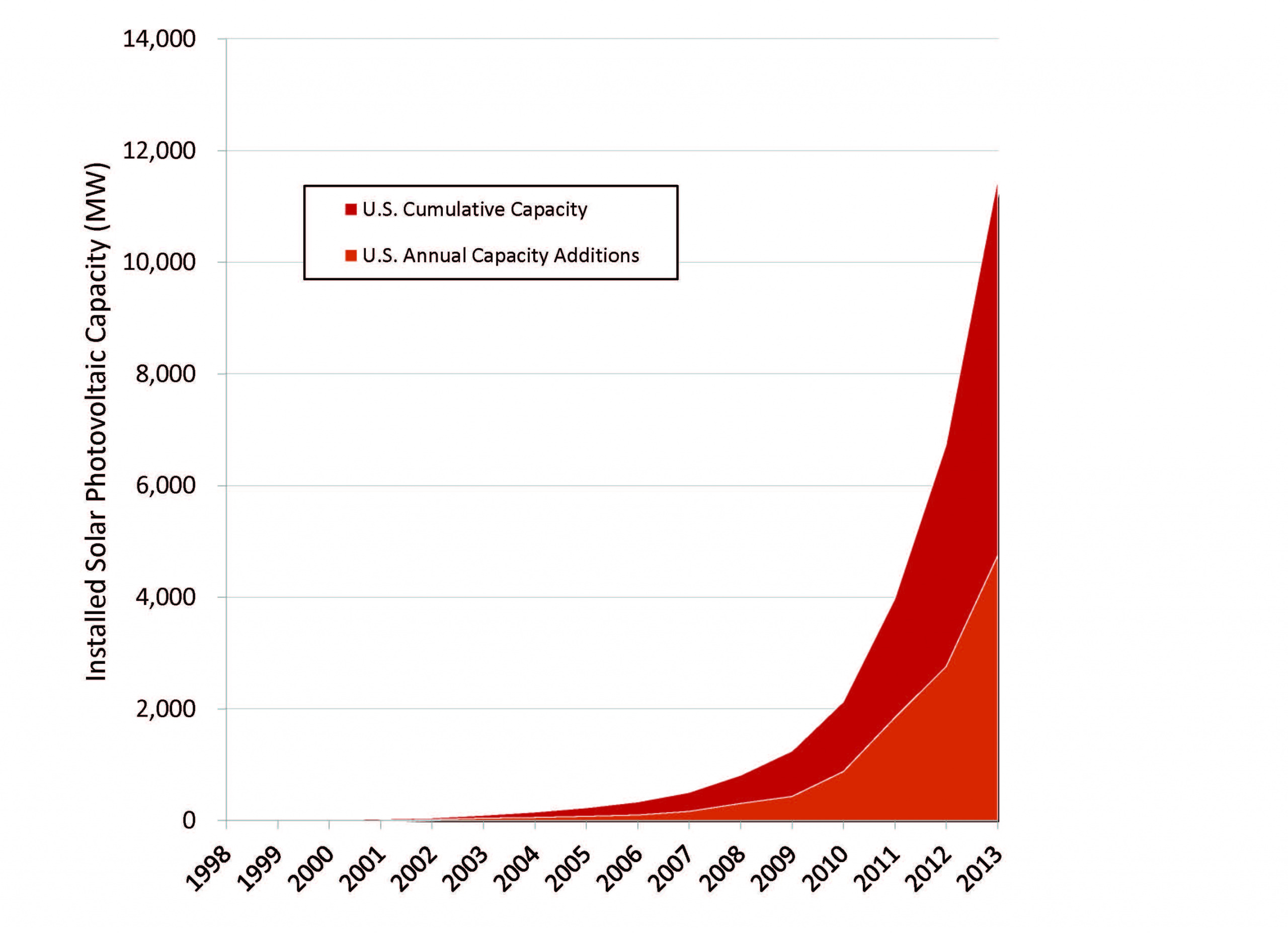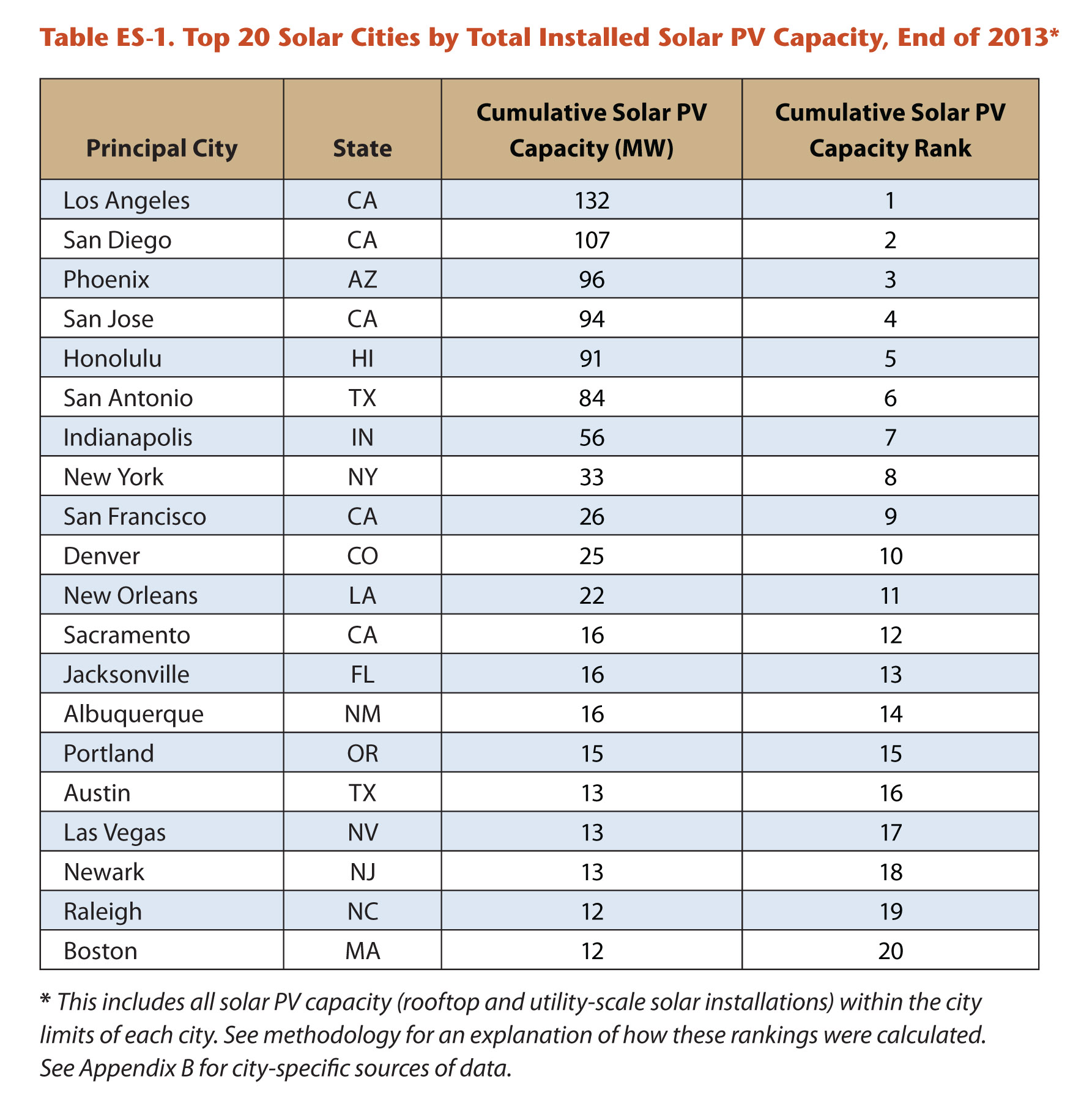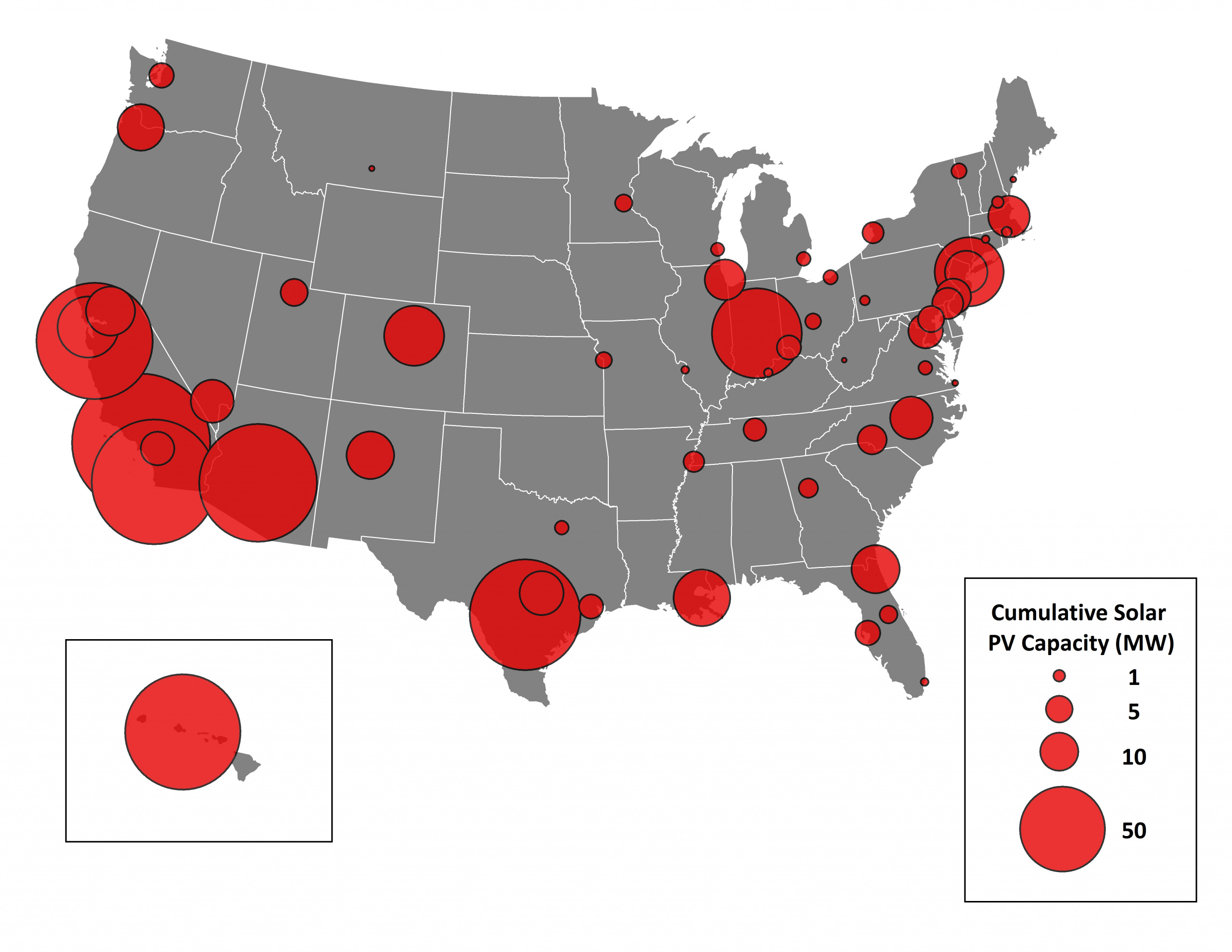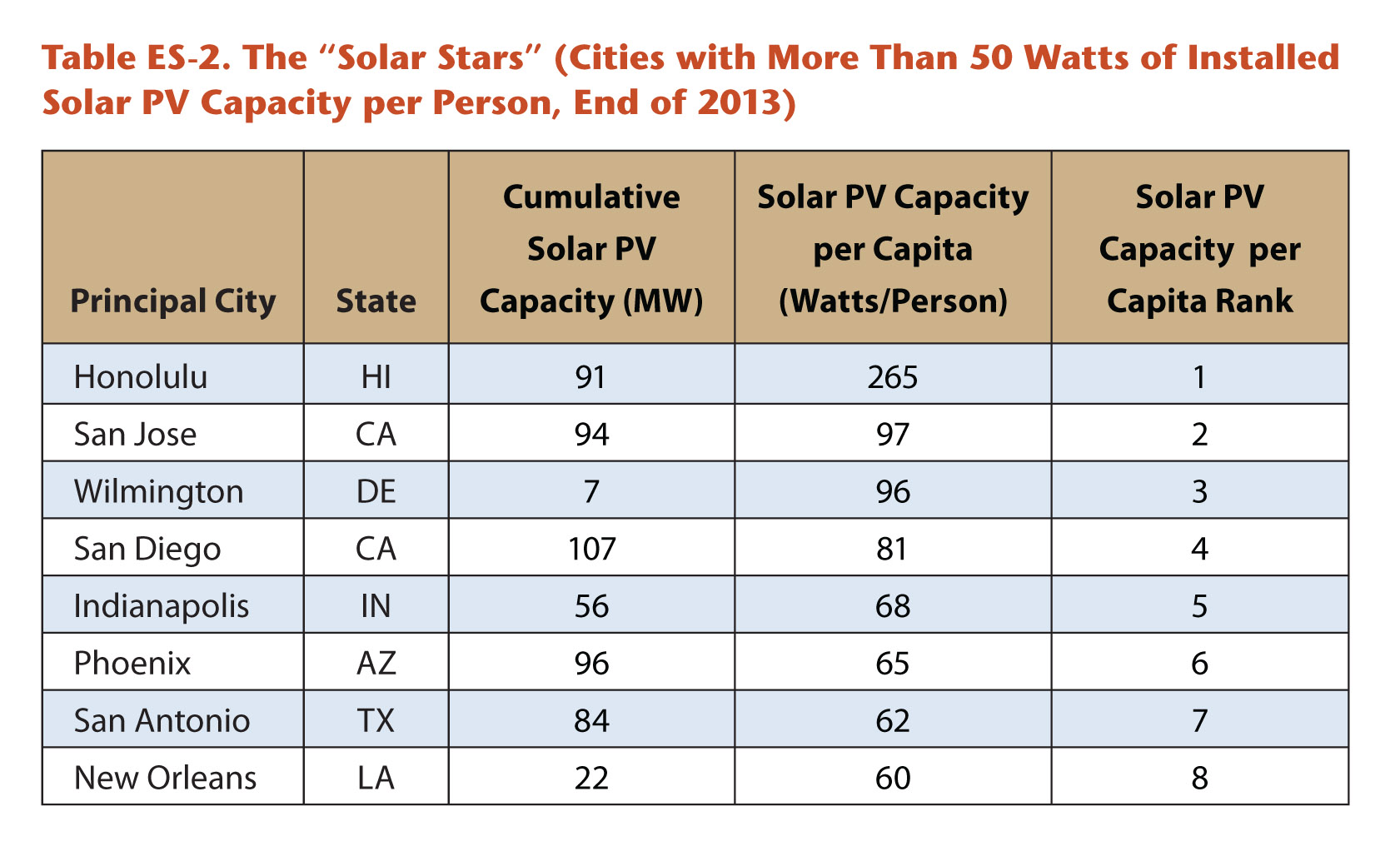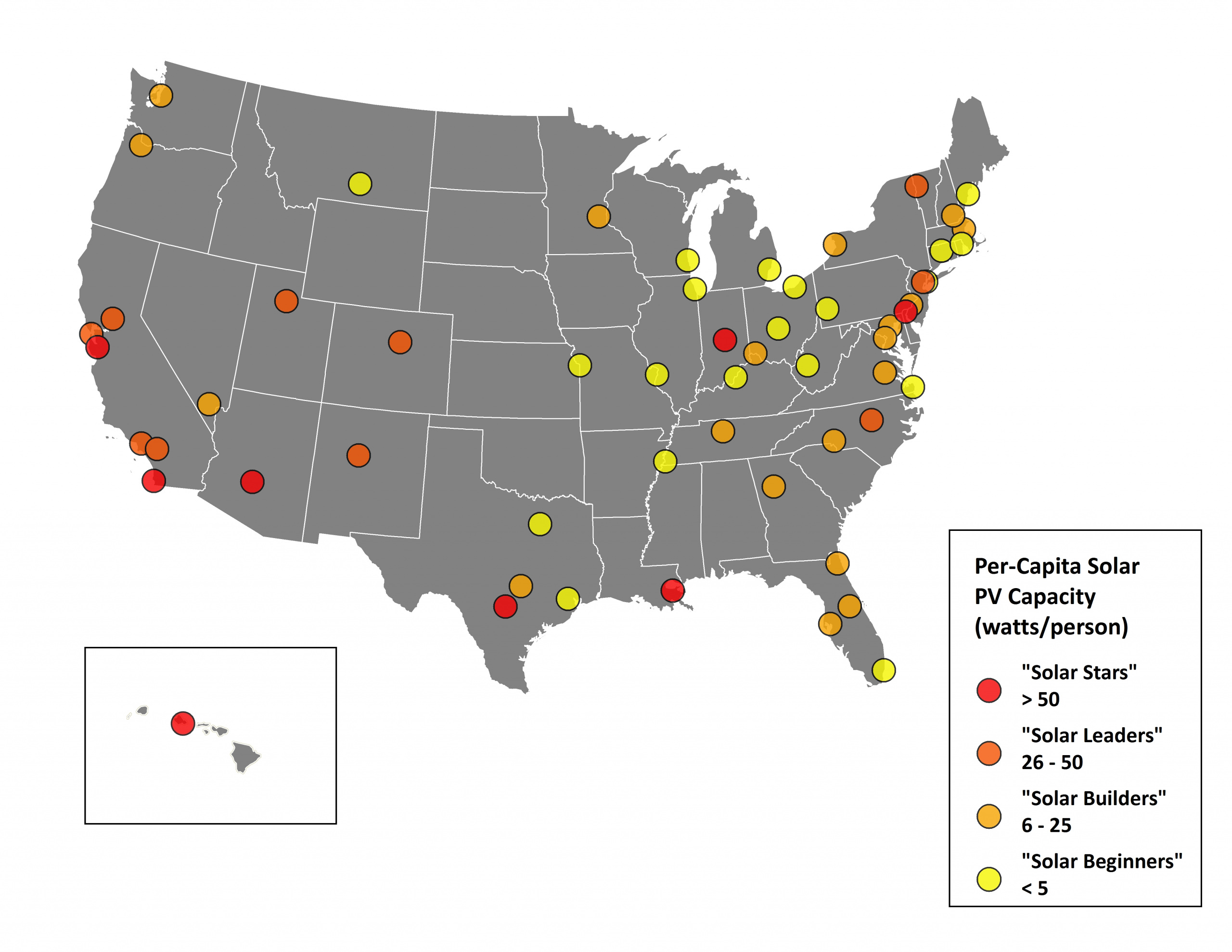Newer editions of this report are available:
Solar power is on the rise across the country. The United States has more than 200 times as much solar photovoltaic (PV) capacity installed today as it did in 2002. With solar module prices coming down, increasing national awareness of solar energy, and a growing legion of solar businesses large and small, solar power is emerging as a mainstream energy solution with widespread benefits for our health, our economy and the environment.
Figure ES-1. Annual and Cumulative Installed Photovoltaic (PV) Capacity through 2013, United States
America’s major cities are helping to lead this clean energy revolution. Forward-thinking local governments and large cities in leading states are benefiting from smart policies that encourage investment in solar PV installations and the growth of local jobs.
This report provides a first-of-its-kind comparative look at the growth of solar power in major American cities. Just 20 cities, representing just 0.1 percent of the land area of the United States, account for 7 percent of solar PV capacity in the United States. These top 20 cities contain more solar power today than was installed in the entire U.S. just six years ago.
Solar energy brings important benefits to cities.
- Solar energy avoids pollution—Pollution-free energy from the sun displaces fossil fuel-powered energy sources, reducing a major source of pollution that contributes to urban smog and global warming. Outdoor air pollutants endanger the health of city residents, and many urban centers are vulnerable to the global warming-induced threats of sea-level rise, increasingly frequent and severe extreme weather events, and the public health impacts of heat waves. Rooftop solar energy also increases city resilience to extreme weather events, which are only due to get worse with increased global warming. For example, solar energy can power cities when drought strikes without diverting precious water resources and help prevent blackouts by reducing strain on the grid. As the electric system evolves, solar panels will be able to provide backup power during power outages caused by storms or other disasters.
- Solar energy protects consumers—Cities often depend on electricity transmitted from power plants hundreds of miles away to meet local demand. Using local solar energy reduces the need for electricity transmission and the need for costly and inefficient “peaking” power plants. Solar energy also typically supplies electricity on hot, sunny days when grids are under the most strain and electricity is most expensive. In addition, since there are no fuel costs associated with solar energy, it can reduce the vulnerability of city economies to price increases for fossil fuels.
- Solar energy helps the economy—Solar power creates local jobs in solar installations and manufacturing. Solar industry employment grew 10 times faster than the national average growth in employment in 2013 and employed 142,000 Americans as of November 2013.
The top 20 cities have a total installed solar PV capacity of over 890 MW and are located in almost every region of the U.S.
Figure ES-2. Map of 57 Principal Cities Ranked by Cumulative Installed Solar PV Capacity, End of 2013
On a per-capita basis, Honolulu is the leading solar city, followed by San Jose, and Wilmington, Delaware.
Figure ES-3. Map of 57 Principal Cities Ranked by Installed Solar PV Capacity per Person, End of 2013
America’s leading solar cities are increasing their use of solar energy in a variety of ways. Some cities are focusing on distributed solar PV on homes and small businesses, others are building utility-scale solar power plants, while still others are developing solar energy at the neighborhood scale or through community projects. What makes these top cities solar leaders?
- Commitment from local governments. Cities can lead and catalyze local markets by installing solar power on city buildings and setting ambitious but achievable targets for solar energy. Leading solar cities, including Denver and Portland, are driving solar growth starting with their public buildings.
- Support from city policies and programs. Cities can create policies that promote solar power in their communities. Cities can encourage local lending for solar projects, provide predictable and accessible tax incentives that make solar energy more affordable and welcoming to businesses, and adopt solar-friendly permitting policies and building codes. New York City, for example, has a property tax credit for residents who install solar panels. Cities can also run “Solarize” programs that use collective purchasing and educational campaigns to help neighbors “go solar” together, as Portland, Oregon did, or create programs to facilitate solar project financing like Property Assessed Clean Energy (PACE) financing.
- Partnership with local utilities. Municipal utilities in several cities have driven the growth of solar power by setting renewable energy goals and offering attractive financial incentives for solar projects. Austin Energy, the municipal utility serving Austin, has set a goal of installing 200 MW of solar power by 2020 and offers an array of solar financing options and monetary incentives to its customers. Seattle City Light allows its customers to invest in community solar projects that are not located on their properties but whose output is still credited on their utility bill. Other cities have effectively partnered with investor-owned utilities to incentivize solar power. New York City partnered with Con Edison, its local investor-owned utility, to connect solar power to the city grid for the first time and create designated “Solar Empowerment Zones” where solar power could deliver the most benefits.
- Strong state-level policies. New Jersey, Delaware and Massachusetts have among the strongest standards in the country, boosting the solar capacity of cities such as Newark, New Jersey, Wilmington, Delaware and Boston, Massachusetts. Hawaii, California, Arizona and New York also benefit from strong state policies that make them home to some of the most prominent solar cities. Net metering policies that allow solar producers to receive the full benefits of their solar power production are important for a robust solar market; states should also allow for virtual net metering that facilitates shared solar projects.
- Support from federal programs. Federal renewable energy tax credits and funding from federal programs like the Solar America Cities program, the Energy Efficiency and Conservation Block Grant program and the U.S. Department of Energy’s Sunshot Initiative provide support for local solar power growth and valuable technical assistance to local governments.
America’s leading cities have made significant progress but have just begun to tap solar energy’s immense potential. Strong public policies at every level of government can help America continue to harness clean solar energy and overcome legislative and regulatory barriers to distributed generation. To achieve America’s full solar potential:
- Local governments should follow the lead of America’s top solar cities by adopting programs that promote the rapid expansion of solar power and by demanding that state and federal officials and investor-owned utilities facilitate that expansion.
- State governments should set ambitious goals for solar energy and adopt policies to meet them. State governments should also use their role as the primary regulators of electric utilities to encourage utility investments in solar energy and implement rate structures that maximize the benefits of solar energy to consumers. States can streamline permitting, inspections and net metering rules to reduce the non-equipment costs of getting solar power on rooftops. States should require that upcoming investments in the electric grid are designed to ensure that clean, distributed energy such as solar power plays a larger role.
- The federal government should continue to provide long-term support for solar power through tax credits and other incentives. The federal government should continue to support research, development and deployment efforts designed to reduce the cost of solar energy and related storage and smart grid technologies; this will enable more solar energy to be reliably incorporated into the electric grid. The federal government should continue to offer programs like the Solar America Cities program, the Energy Efficiency Conservation Block Grant program and the U.S. Department of Energy’s Sunshot Initiative, which provide support and technical assistance while fostering innovations that drive solar development at the state and local levels.
- All levels of government should lead by example by installing solar energy technologies on government buildings.
